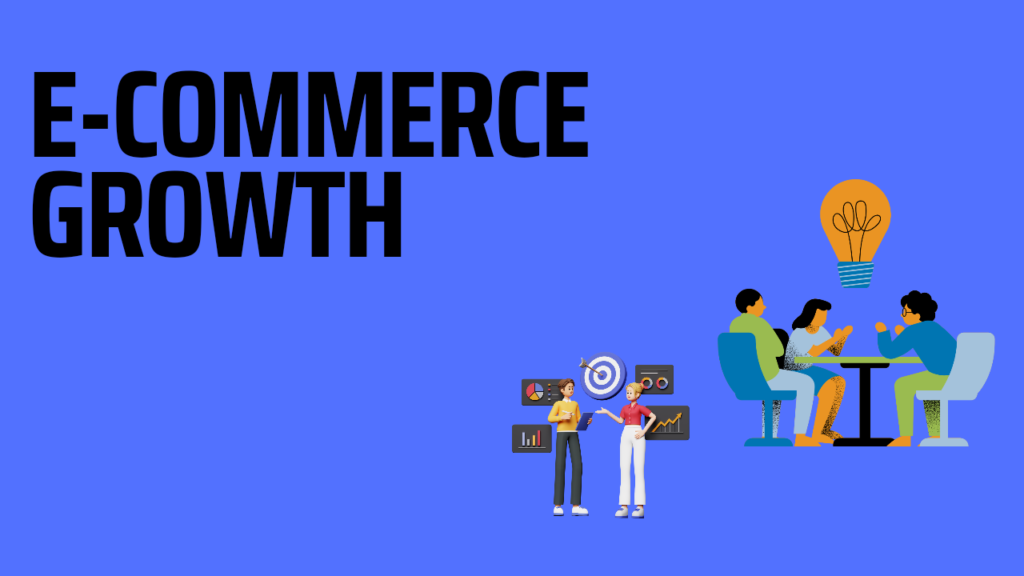E-COMMERCE GROWTH

E-commerce growth continues to be a significant trend, driven by various factors that shape the way businesses operate and consumers shop. Here are key aspects contributing to the ongoing growth of e-commerce:
- Consumer Convenience: E-commerce provides the convenience of shopping anytime, anywhere, allowing consumers to browse and make purchases at their convenience, contributing to the steady growth of online retail.
- Mobile Commerce (M-Commerce): The widespread use of smartphones has facilitated the growth of mobile commerce, enabling consumers to shop on mobile devices, further expanding the reach of e-commerce.
- Global Reach: E-commerce allows businesses to reach a global audience, breaking down geographical barriers and opening up new markets for products and services.
- Diverse Product Offerings: E-commerce platforms offer a wide array of products, often more than what can be found in physical stores. This diversity attracts consumers looking for specific or niche products.
- Personalization: E-commerce sites leverage data analytics and artificial intelligence to personalize the shopping experience, providing tailored recommendations and targeted marketing, enhancing customer engagement and satisfaction.
- Streamlined Checkout Processes: Efforts to simplify and optimize the online purchasing process contribute to increased conversion rates and customer satisfaction.
- Social Commerce: Integration with social media platforms allows for seamless shopping experiences directly through social channels, leveraging social influence and recommendations.
- Subscription Models: Subscription-based e-commerce models, offering regular deliveries of products or services, have gained popularity, providing businesses with predictable revenue streams.
- Easier Entry for Small Businesses: E-commerce provides a platform for small and independent businesses to compete on a global scale, fostering entrepreneurship and economic growth.
- Technological Advancements: Innovations such as augmented reality (AR) for virtual try-ons and improved product visualization enhance the online shopping experience, contributing to e-commerce growth.
- Flexible Payment Options: The availability of various payment methods, including digital wallets and buy-now-pay-later options, accommodates diverse consumer preferences and increases accessibility.
- Supply Chain Optimization: E-commerce companies invest in optimizing supply chain logistics to ensure efficient and timely delivery, enhancing customer satisfaction and loyalty.
- Evolving Consumer Behavior: Changes in consumer behavior, including a preference for online shopping and digital transactions, drive the continuous growth of e-commerce.
- Environmental Considerations: E-commerce businesses are increasingly focusing on sustainable practices, addressing environmental concerns and meeting the expectations of environmentally conscious consumers.
- Pandemic Impact: The COVID-19 pandemic accelerated the shift towards e-commerce as lockdowns and safety concerns prompted more people to turn to online shopping.
Businesses that adapt to these trends, prioritize customer experience, and stay agile in response to evolving market dynamics are likely to thrive in the continually growing e-commerce landscape.
E-commerce growth has been a significant trend, and several factors contribute to its expansion. Here are key aspects influencing the growth of e-commerce:
- Consumer Convenience: E-commerce provides the convenience of shopping from anywhere at any time, contributing to its widespread adoption.
- Mobile Commerce (M-Commerce): The rise of smartphones and mobile apps has facilitated seamless mobile shopping experiences, contributing significantly to e-commerce growth.
- Global Market Access: E-commerce enables businesses to reach a global audience, breaking down geographical barriers and expanding market reach.
- Diverse Product Offerings: E-commerce platforms offer a vast array of products, allowing consumers to find a wide range of options in one place.
- Personalized Shopping Experience: Advanced algorithms and data analytics enable personalized recommendations, enhancing the overall shopping experience for consumers.
- Secure Payment Options: Improved online security measures and diverse payment options, including digital wallets and cryptocurrencies, have increased consumer trust in online transactions.
- Easier Price Comparison: Consumers can easily compare prices and reviews online, making informed purchasing decisions and contributing to increased competition among e-commerce businesses.
- Subscription Models: The rise of subscription-based models, such as subscription boxes and services, provides a predictable revenue stream for businesses.
- Social Commerce: Integration with social media platforms allows businesses to sell products directly through social channels, tapping into the vast user bases of platforms like Facebook and Instagram.
- Technological Advancements: Innovations such as augmented reality (AR) and virtual reality (VR) enhance the online shopping experience, allowing consumers to virtually try products before making a purchase.
- Supply Chain Optimization: E-commerce businesses are investing in efficient supply chain management, reducing delivery times and improving overall logistics.
- Customer Reviews and Ratings: Transparent customer feedback on products and services helps build trust and influences purchasing decisions, contributing to the growth of e-commerce.
- Sustainability Focus: Many e-commerce businesses are adopting sustainable practices, appealing to environmentally conscious consumers.
- Easier Market Entry: E-commerce lowers the barriers to entry for businesses, allowing small and niche players to compete alongside larger retailers.
- Pandemic Acceleration: The COVID-19 pandemic accelerated the shift to online shopping as consumers sought contactless options, further boosting e-commerce growth.
Understanding and adapting to these trends can be crucial for businesses looking to thrive in the evolving landscape of e-commerce. It’s essential for e-commerce businesses to stay agile, embrace technological advancements, and prioritize customer experience to sustain and foster growth.
E-commerce growth has been a prominent trend, and understanding its key drivers and factors can be crucial for businesses. Here are some insights into the growth of e-commerce:
- Digital Transformation: The shift towards online shopping is driven by the broader digital transformation. Consumers increasingly prefer the convenience of shopping from anywhere at any time.
- Mobile Commerce (M-Commerce): The widespread use of smartphones has fueled the growth of mobile commerce. E-commerce platforms are optimizing their websites and apps for mobile devices, making it easier for users to shop on the go.
- Global Reach: E-commerce allows businesses to reach a global audience. Cross-border e-commerce is growing as consumers can purchase products from international retailers with ease.
- Improved Technology: Advancements in technology, such as faster and more secure payment gateways, augmented reality for virtual try-ons, and AI-driven personalization, enhance the overall online shopping experience.






